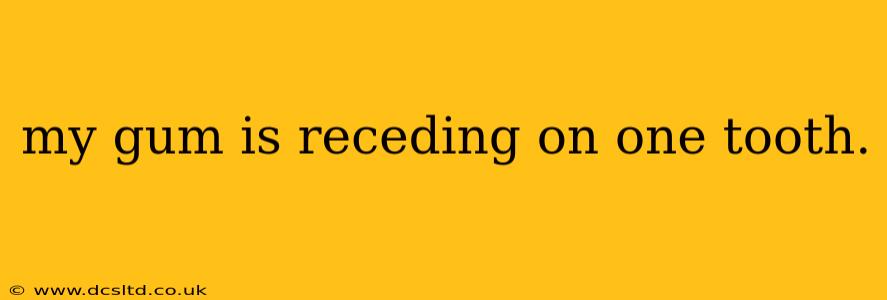Gum recession, where your gums pull back from your teeth, exposing more of the tooth root, is a common dental problem. While it can occur on multiple teeth, experiencing it on just one tooth can be particularly concerning. This article will delve into the potential causes, effective treatments, and crucial preventative measures for receding gums, focusing specifically on the scenario where only one tooth is affected.
Why is My Gum Receding on Only One Tooth?
This localized recession often points to a specific underlying issue, rather than a generalized gum disease affecting the entire mouth. Several factors could contribute:
- Aggressive Brushing: Brushing too hard, using a hard-bristled toothbrush, or using a toothbrush with abrasive bristles can wear away gum tissue over time, leading to recession, particularly in one vulnerable area.
- Improper Brushing Technique: Incorrect brushing habits can concentrate pressure on a single tooth, causing localized gum recession.
- Periodontal Disease (Localized): While gum disease usually affects multiple teeth, it can sometimes manifest initially or predominantly on a single tooth. This is a serious concern and requires professional intervention. Ignoring it can lead to bone loss and eventual tooth loss.
- Trauma: A direct injury to the gum tissue around a single tooth—from a blow, accidental bite, or poorly fitting dental work—can result in recession.
- Tooth Anatomy: The natural shape and position of a tooth can sometimes predispose it to gum recession.
- Malocclusion (Bad Bite): An improper bite, where teeth don't align correctly, can create excessive pressure on specific teeth, potentially causing gum recession on that single tooth.
- Clenching or Grinding (Bruxism): Habitual clenching or grinding of teeth, particularly at night, can put undue stress on individual teeth, contributing to gum recession.
- Genetics: A family history of gum recession increases your susceptibility.
What are the Treatments for Receding Gums on One Tooth?
The treatment approach depends heavily on the underlying cause and the severity of the recession. Your dentist will conduct a thorough examination to determine the best course of action. Options may include:
- Improved Oral Hygiene: If aggressive brushing or improper technique is the culprit, your dentist will instruct you on proper brushing and flossing techniques, possibly recommending a softer toothbrush and a specialized fluoride toothpaste.
- Scaling and Root Planing: If periodontal disease is involved, this deep cleaning procedure removes plaque and tartar from below the gum line, smoothing the tooth roots to promote healing.
- Gum Graft Surgery: This surgical procedure involves taking tissue from another area of your mouth (usually the palate) and grafting it onto the affected area to cover the exposed tooth root. Different types of gum grafts exist, and your dentist will recommend the most appropriate one based on your specific needs.
- Enamel Matrix Derivative (EMD) Gel: This gel is sometimes used to stimulate gum tissue regeneration.
- Guided Tissue Regeneration (GTR): This technique involves placing a small membrane between the bone and the gum tissue to encourage regeneration of lost bone and tissue.
- Pinhole Surgical Technique (PST): A minimally invasive procedure where tiny holes are created in the gum tissue to allow for repositioning.
Can Receding Gums on One Tooth Be Prevented?
Absolutely! Preventing gum recession involves diligent preventative care:
- Gentle Brushing: Use a soft-bristled toothbrush and brush gently with short strokes.
- Proper Brushing Technique: Learn and follow the proper brushing technique recommended by your dentist. The Bass technique is commonly recommended.
- Regular Flossing: Floss daily to remove plaque and food particles from between your teeth.
- Regular Dental Checkups: Schedule regular checkups and professional cleanings to monitor your gum health and catch problems early.
- Mouthguards (for Bruxism): If you clench or grind your teeth, consider using a mouthguard to protect your teeth and gums.
How Do I Know if My Receding Gums Require Immediate Attention?
Seek immediate dental attention if you notice:
- Significant gum recession: A noticeable pulling back of your gums.
- Loose teeth: This indicates potential bone loss.
- Bleeding gums: While some bleeding is normal, persistent bleeding is a warning sign.
- Sensitivity to hot or cold: Exposed tooth roots are more sensitive.
- Pain or discomfort: Any pain in your gums or teeth should be addressed promptly.
By addressing receding gums promptly and maintaining excellent oral hygiene, you can significantly reduce the risk of further damage and preserve the health of your teeth and gums. Remember to consult your dentist for a proper diagnosis and personalized treatment plan. They're best equipped to assess your specific situation and recommend the most effective course of action.
